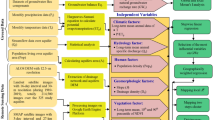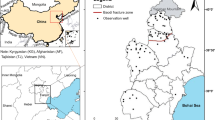Abstract
Increased demand for water resources together with the influence of climate change has degraded water conditions which support vegetation in many parts of the world, especially in arid and semiarid areas. This study develops an integrated framework to assess the impact of precipitation and groundwater on vegetation growth in the Xiliao River Plain of northern China. The integrated framework systematically combines remote sensing technology with water flow modeling in the vadose zone and field data analysis. The vegetation growth is quantitatively evaluated with the remote sensing data by the normalized difference vegetation index (NDVI) and the simulated plant water uptake rates. The correlations among precipitation, groundwater depth and NDVI are investigated using Pearson correlation equations. The results provide insights for understanding interactions between precipitation and groundwater and their contributions to vegetation growth. Strong correlations between groundwater depth, plant water uptake and NDVI are found in parts of the study area during a ten-year drought period. The numerical modeling results indicate that there is an increased correlation between the groundwater depth and vegetation growth and that groundwater significantly contributes to sustaining effective soil moisture for vegetation growth during the long drought period. Therefore, a decreasing groundwater table might pose a great threat to the survival of vegetation during a long drought period.







Similar content being viewed by others
References
Anyamba A, Tucker CJ (2005) Analysis of Sahelian vegetation dynamics using NOAA-AVHRR NDVI data from 1981–2003. J Arid Environ 63(4):596–614. doi:10.1016/j.jaridenv.2005.03.007
Box EO, Holben BN, Kalb V (1989) Accuracy of AVHHR vegetation index as a predictor of biomass, primary productivity and net CO2 flux. Vegetatio 80:71–89. doi:10.1007/BF00048034
Brogaard S, Prieler S (1998) Land cover in the Horqin Grasslands, North China. Detecting changes between 1975 and 1990 by means of remote sensing. Interim Report, International Institute for Applied Systems Analysis. Austria
Brogaard S, Runnström M, Seaquist JW (2005) Primary production of Inner Mongolia, China, between 1982 and 1999, estimated by a satellite-driven light use efficiency model. Global Planet Change 45(4):313–332. doi:10.1016/j.gloplacha.2004.09.012
Brolsma RJ, Karssenberg D, Bierkens MFP (2010a) Vegetation competition model for water and light limitation. I: model description, one-dimensional competition and the influence of groundwater. Ecol Model 221(10):1348–1363. doi:10.1016/j.ecolmodel.2010.02.012
Brolsma RJ, Karssenberg D, Bierkens MFP (2010b) Vegetation competition model for water and light limitation. II: spatial dynamics of groundwater and vegetation. Ecol Model 221(10):1364–1377. doi:10.1016/j.ecolmodel.2010.02.010
Chen Y, Li W, Xu C, Ye Z, Chen Y (2015) Desert riparian vegetation and groundwater in the lower reaches of the Tarim River basin. Environ Earth Sci. 73:547–558. doi:10.1007/s12665-013-3002-y
Cheng DH, Wang WK, Chen XH, Hou GC, Yang HB, Li Y (2011) A model for evaluating the influence of water and salt on vegetation in a semi-arid desert region, northern China. Environ Earth Sci 64:337–346. doi:10.1007/s12665-010-0854-2
Childress WM, Coldren CL, McLendon T (2002) Applying a complex, general ecosystem model (EDYS) in large scale land management. Ecol Model 153:97–108. doi:10.1016/S0304-3800(01)00504-X
Chui TFM, Low SY, Liong SY (2011) An ecohydrological model for studying groundwater–vegetation interactions in wetlands. J Hydrol 409:291–304. doi:10.1016/j.jhydrol.2011.08.039
Condon LE, Maxwell RM (2014) Groundwater-fed irrigation impacts spatially distributed temporal scaling behavior of the natural system: a spatio-temporal framework for understanding water management impacts. Environ Res Lett 9:034009. doi:10.1088/1748-9326/9/3/034009
Dai Z, Samper J (2004) Inverse problem of multicomponent reactive chemical transport in porous media: formulation and applications. Water Resour Res 40:W07407. doi:10.1029/2004WR003248
Dai Z, Samper J, Wolfsberg A, Levitt D (2008) Identification of relative conductivity models for water flow and solute transport in unsaturated compacted bentonite. Phys Chem Earth 33:S177–S185. doi:10.1016/j.pce.2008.10.012
Dai Z, Keating E, Bacon D, Viswanathan H, Stauffer P, Jordan A, Pawar R (2014) Probabilistic evaluation of shallow groundwater resources at a hypothetical carbon sequestration site. Sci Rep 4:4006. doi:10.1038/srep04006
Davenport ML, Nicholson SE (1993) On the relation between precipitation and the normalized difference vegetation index for diverse vegetation types in East Africa. Int J Remote Sens 14(12):2369–2389. doi:10.1080/01431169308954042
De Paola F, Ranucci A (2012) Analysis of spatial variability for stormwater capture tank assessment. Irrig Drain 61:682–690. doi:10.1002/ird.1675
De Paola F, Ranucci A, Feo A (2013) Antecedent moisture condition (SCS) frequency assessment: a case study in southern Italy. Irrig Drain 62:61–71. doi:10.1002/ird.1801
De Paola F, Giugni M, Topa ME, Bucchignani E (2014) Intensity-duration-frequency (IDF) rainfall curves, for data series and climate projection in African cities. SpringerPlus 3:133. doi:10.1186/2193-1801-3-133
Feddes RA, Bresler E, Neuman SP (1974) Field test of a modified numerical model for water uptake by root systems. Water Resour Res 10(6):1199–1206. doi:10.1029/WR010i006p01199
Froend R, Sommer B (2010) Phreatophytic vegetation response to climatic and abstraction-induced groundwater drawdown: examples of long-term spatial and temporal variability in community response. Ecol Eng 36:1191–1200. doi:10.1016/j.ecoleng.2009.11.029
Gao ZQ, Dennis O (2001) The temporal and spatial relationship between NDVI and climatological parameters in Colorado. J Geogr Sci 11(4):411–419. doi:10.1007/BF02837968
Gebremichael M, Barros AP (2006) Evaluation of MODIS gross primary productivity (GPP) in tropical monsoon regions. Remote Sens Environ 100(2):150–166. doi:10.1016/j.rse.2005.10.009
Groeneveld DP, Baugh WM (2007) Correcting satellite data to detect vegetation signal for eco-hydrologic analyses. J Hydrol 344(1):135–145. doi:10.1016/j.jhydrol.2007.07.001
Habib AS, Chen X, Gong J, Wang H, Zhang L (2009) Analysis of China vegetation dynamics using NOAA-AVHRR data from 1982 to 2001. Geo-spatial Inf Sci 12(2):146–153. doi:10.1007/s11806-009-0003-9
Ichii K, Kawabata A, Yamaguchi Y (2002) Global correlation analysis for NDVI and climatic variables and NDVI trends: 1982–1990. Int J Remote Sens 23(18):3873–3878. doi:10.1080/01431160110119416
Ji L, Peters AJ (2004) A spatial regression procedure for evaluating the relationship between AVHRR-NDVI and climate in the northern Great Plains. J Remote Sens 25(2):297–311. doi:10.1080/0143116031000102548
Jin XM, Wan L, Zhang YK, Xue ZQ, Yin Y (2007) A study of the relationship between vegetation growth and groundwater in the Yinchuan plain. Earth Sci Front 14(3):197–203. doi:10.1016/S1872-5791(07)60026-8
Jin XM, Guo RH, Zhang Q, Zhou YX, Zhang DR, Yang Z (2014) Response of vegetation pattern to different landform and water depth in Hailiutu River basin, Northwestern China. Environ Earth Sci 71:4889–4898. doi:10.1007/s12665-013-2882-1
Kotowski W, Andel J, Diggelen R, Hogendorf J (2001) Responses of fen plant species to groundwater level and light intensity. Plant Ecol 155(2):147–156. doi:10.1023/A:1013214716842
Li X, Li X, Chen Y, Yi G (2007) Temporal responses of vegetation to climate variables in temperate steppe of northern China. J Plant Ecol 31(6):1054–1062 (In Chinese)
Naumburg E, Mata-Gonzalez R, Hunter R, Mclendon T, Martin D (2005) Phreatophytic vegetation and groundwater fluctions: a review of current research and application of ecosystem response modeling with an emphasis on Great basin vegetation. Environ Manag 35(6):726–740. doi:10.1007/s00267-004-0194-7
Richard Y, Poccard I (1998) A statistical study of NDVI sensitivity to seasonal and interannaul precipitation variations in Southern Africa. Int J Remote Sens 19(15):2907–2920. doi:10.1080/014311698214343
Runnström MC (2003) Rangeland development of the Mu Us Sandy Land in semiarid China: an analysis using Landsat and NOAA remote sensing data. Land Degrad Dev 14(2):189–202. doi:10.1002/ldr.545
Santos P, Negri AJ (1997) A comparison of the normalized difference vegetation index and precipitation for the Amazon and Northeastern Brazil. J Appl Meteorol 36(7):958–965. doi:10.1175/1520-0450(1997)036<0958:ACOTND>2.0.CO;2
Sarkar S, Kafatos M (2004) Interannual variability of vegetation over the Indian sub-continent and its relation to the different meteorological parameters. Remote Sens Environ 90(2):268–280. doi:10.1016/j.rse.2004.01.003
Schultz PA, Halpert MS (1995) Global analysis of the relationships among a vegetation index, precipitation and land surface temperature. Int J Remote Sens 16(15):2755–2777. doi:10.1080/01431169508954590
Seaquist JW, Olsson L, Ardo J (2003) A remote sensing-based primary production model for grassland biomes. Ecol Model 169(1):131–155. doi:10.1016/S0304-3800(03)00267-9
Sharone EN, Michaell LD, Adar RM (1990) A comparison of the vegetation response to rainfall in the Sahel and East Africa using normalized difference vegetation index from NOAA AVHRR. Clim Change 17(9):209–241
Šimůnek J, Hopmans JW (2009) Modeling compensated root water and nutrient uptake. Ecol Model 220(4):505–521. doi:10.1016/j.ecolmodel.2008.11.004
Šimůnek J, van Genuchten MT, Šejna M (2008) Development and applications of the HYDRUS and STANMOD software packages and related codes. Vadose Zone J 7(2):587–600. doi:10.2136/vzj2007.0077
Šimůnek J, van Genuchten MT, Šejna M (2011) The HYDRUS Software Package for Simulating Two- and Three-Dimensional Movement of Water, Heat, and Multiple Solutes in Variably-Saturated Media, Technical Manual, Version 2.0, PC Progress, Prague, Czech Republic, pp 258
Stromberg JC, Tiller R, Richter B (1996) Effects of groundwater decline on riparian vegetation of semiarid regions: the San Pedro, Arizona. Ecol Appl 6(1):113–131. doi:10.2307/2269558
Tillman FD, Callegary JB, Nagler PL, Glenn EP (2012) A simple method for estimating basin-scale groundwater discharge by vegetation in the basin and range province of Arizona using remote sensing information and geographic information systems. J Arid Environ 82:44–52. doi:10.1016/j.jaridenv.2012.02.010
van Genuchten MT (1980) A closed-form equation for predicting the hydraulic conductivity of unsaturated soils. Soil Sci Soc Am J 44:892–898. doi:10.2136/sssaj1980.03615995004400050002x
van Genuchten MT (1987) A numerical model for water and solute movement in and below the root zone. Research Report No 121, U.S. Salinity laboratory, USDA, ARS, Riverside, California
Wang J, Price KP, Rich PM (2001) Spatial patterns of NDVI in response to precipitation and temperature in the central Great Plains. Int J Remote Sens 22(18):3827–3844. doi:10.1080/01431160010007033
Zhang L, Dawes WR, Hatton TJ (1996) Modelling hydrologic processes using a biophysically based model: application of WAVES to FILE and HAPEX-MOBILHY. J Hydrol 185:147–169. doi:10.1016/0022-1694(95)03006-9
Zhang GL, Xu XL, Zhou XP, Zhang HB, Ouyang H (2011) Responses of vegetation changes to climatic variations in Hulun Buir grassland in past 30 years. Acta Geograph Sin 66(1):47–58 (in Chinese)
Zhao L, Zhu L (2012) Research on method of extracting vegetation information based on band combination. In: Geoinformatics, 2012 20th international conference, pp 1–5. doi: 10.1109/Geoinformatics.2012.6270287
Zhou H, Wang J, Chen S (2007) Analysis of effects of “Grain for Green” program using temporal NDVI and rainfall series. J Soil Water Conserv 22(4):70–74 (Chinese)
Acknowledgments
This work was supported by National Natural Science (Nos. 41201420, 41130744), Beijing Nova Program (No. Z111106054511097) and Beijing Young Talent Plan. The authors are thankful to Xinyin Cui of the Songliao Water Resource Committee for providing the field data.
Author information
Authors and Affiliations
Corresponding author
Rights and permissions
About this article
Cite this article
Zhu, L., Gong, H., Dai, Z. et al. An integrated assessment of the impact of precipitation and groundwater on vegetation growth in arid and semiarid areas. Environ Earth Sci 74, 5009–5021 (2015). https://doi.org/10.1007/s12665-015-4513-5
Received:
Accepted:
Published:
Issue Date:
DOI: https://doi.org/10.1007/s12665-015-4513-5




